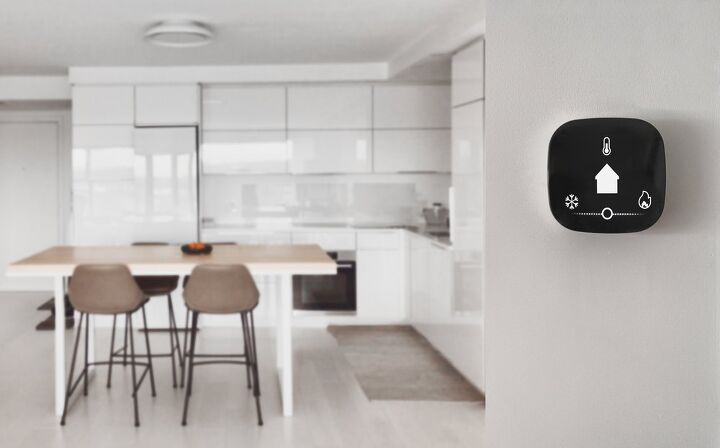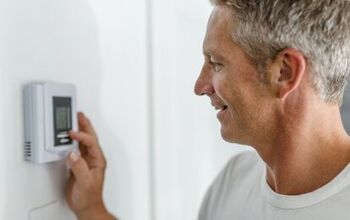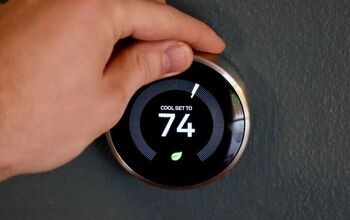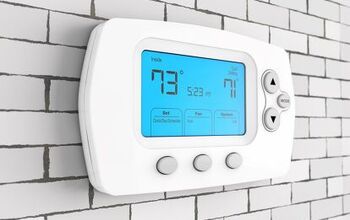Alarm.com Thermostat Not Cooling? (Possible Causes & Fixes)

When summer rolls around, your home’s air conditioner is one of the only things that can offer you respite from the heat. As far as smart thermostats go, the Alarm.com thermostat is a strong contender. However, as is the case with many thermostats, its cooling capabilities can malfunction.
If your Alarm.com thermostat is not cooling your home, it could indicate a problem with the power source, wiring, fan, or the unit itself. Fixing this issue can lead you down many different paths, ranging from basic checkups to advanced troubleshooting methods. It’s important to exhaust all your options and be thorough to correctly identify the main issue.
Unfortunately, thermostat issues are not uncommon. A functional HVAC unit is almost required to live comfortably, which is why it’s even more important to know how to fix common cooling problems.
Do You Need Your Thermostat Repaired or Reprogrammed?
Get free, zero-commitment quotes from pro contractors near you.

Heat Pump vs. Conventional Systems
Both heat pumps and air conditioners use compressed refrigerant to collect heat from your home and move it outside. Both are similar in terms of energy efficiency and cost-effectiveness, too. However, a conventional air conditioner will generally last longer than a heat pump since it is only used for part of the year.
A heat pump is usually located outside of the house and will either provide heat or cool air depending on the position of the reversing valve. It looks the exact same as a normal AC unit, and when in cooling mode, they operate in similar ways. However, it can still be useful to know the difference.
Heat pumps will usually have the following wires:
- R or RH/RC Wires: These relay to close the electrical circuit to the control board.
- Y and Y2 Wires: These operate the condenser, which collects and releases heat.
- W, W2, Aux, and E Wires: These control auxiliary and emergency heating stages.
- G Wires: These operate the fan.
- O or B Wires: O wires are more commonly used than B alternatives, but one of them is needed to operate the reversing valve.
A conventional system includes a furnace, boiler, water radiator, and in-floor radiant heat. An air conditioner alone cannot heat your home, which is why a heating unit is always paired with it. These systems generally feature these wires:
- R or RH/RC Wires: As with a heat pump, these wires relay to close the circuit to the control board.
- Y and Y2 Wires: These operate the condenser for all the air conditioning stages.
- W and W2 Wires: These operate the heating stages.
- G Wires: These operate the fan.
Why Your System is Not Cooling Your Home
A faulty thermostat can start as a minor annoyance, but it can quickly turn into a larger issue if left unchecked. There are many causes to cooling malfunctions with your Alarm.com thermostat that you should consider, so you can get it back in working condition as quickly as possible.
Power Issues
Sometimes, your air conditioner won’t turn on at all. When this happens, it’s likely to be an issue with your power source in general. This could be due to a tripped circuit breaker or blown fuse. With a breaker, all you’ll have to do is flip it back on. With a fuse, you’ll have to replace it all together.
Wiring Issues
If you’re concerned about the wiring, the process to identify the source of the problem is straightforward. For starters, you should make sure the wires are stripped to the correct length and are completely inserted into the terminal. To do this, you can tug on the wire to see if it is loose or remove it and re-insert it.
Fan Issues
There are a few different issues that can arise with your fan that will affect the cooling capabilities of your thermostat. The most prominent one is that the fan isn’t running when the AC kicks on. If you’re experiencing issues with your fan, here’s what you should do:
- Verify the setpoint
- Check thermostat configuration
- Check the jumper and wire connection
- Make sure you’re not in a Compressor Delay timeout
If your fan is running without cooling, there are a couple different things you can check. If you have a conventional AC system, you should check the W terminal too make sure it is wired properly with a digital multi-meter.
You should also look for a missing jumper, as this can cause power failures. With a heat pump, you’ll have to do the same with the Y terminal instead of the W terminal.
Another common issue with heat pumps is the system heating when it is supposed to cool and vice versa. This would be due to the reversing valve, which is the O/B terminal, being backwards.
Battery Issues
Generally, a thermostat’s lifespan can reach about a decade. That said, you will have to replace the batteries every now and then to maintain full functionality. Your Alarm.com thermostat will likely last well over a year with normal battery power.
However, this can last even longer if your thermostat is powered through a C-wire, which connects it directly to the HVAC unit. With a C-wire in the picture, the batteries are only needed when the power goes out.
What You Can Do About It
Now that you know a few of the most common causes of these issues, we’ll talk about what you can do to fix them.
Do a Once Over
Before you start trying to fix your thermostat, it’s important to fully assess the situation. That way, you can move forward with an educated plan in mind. The first thing you should do is make sure your thermostat and HVAC system are running.
Then, check the thermostat itself locally to see if there are communication issues between it and the panel or between Alarm.com and the panel. Any sort of connection errors can cause glitches that impact your home’s interior temperature.
Next, make sure your thermostat is set to the right mode and that the setpoint, or the temperature you desire in your home, is below the ambient temperature. Otherwise, it won’t register that it needs to cool anymore than it already has.
Basic Troubleshooting Methods
As you begin to look for the bigger issue, there are a few methods you can try out. First, make sure your thermostat is showing up when you log in to the Alarm.com website or app. If it’s not, you may have to reach out to their support team to reconnect your device.
Another thing you can do is listen for your thermostat to click as it is kicking on to cool the house. To do this, you’ll need it to be fairly quiet in your home. Otherwise, you can easily miss it. If you want a quick way to test this, follow these simple steps:
- Turn the thermostat to off mode
- Wait 5 minutes to account for any delays
- Set your thermostat to cool
- Wait to listen for the click
If your system clicks, it signifies it is trying to cool. The click will sound as it opens or closes relays. Other things you should check out are issues with the jumper and wire connections.
Common Problems with Heating Functions
If you’re experiencing issues with cooling through your Alarm.com thermostat, you may find you’ll have issues with heating, too. You can deal with many of these problems in a similar fashion as the cooling unit. These issues include:
- Heat isn’t turning on
- System isn’t heating
- AUX heat not functioning
- Heat pump is not running
- Fan problems
Related Questions
What type of thermostat does Alarm.com use?
Alarm.com uses a Z-Wave compatible thermostat, which works with a wide range of brands and home automation systems. This makes them a convenient option for many homeowners.
How do I add my thermostat to the Alarm.com app?
First, download the Alarm.com app and navigate to the option to add a new device to your network for monitoring. There are multiple versions of the app that can be used on smartphones, tablets, Apple Watches, and voice-controlled technology like Alexa and Google Home.
How do I remove a thermostat from Alarm.com?
To remove a thermostat from your network, you will have to contact your monitoring company. They will have to complete this process on their end.
Do You Need Your Thermostat Repaired or Reprogrammed?
Get free, zero-commitment quotes from pro contractors near you.

Conclusion
The Alarm.com thermostat is simple in design, which makes it a user-friendly option for homeowners. This also helps simplify the troubleshooting process when things go wrong. If your thermostat stops effectively cooling your home, there are many things you can do on your own to try to fix the problem.
However, if you’re unfamiliar with the innerworkings of your system, you may be better off reaching out to a professional to come take a look. You can also search for more specialized help videos in the Alarm.com Resources Hub.

I am a copywriter and editor based in the Las Vegas area with nearly a decade of experience under my belt writing landing pages, cost guides, blog posts, newsletters, case studies, and social media content. I have a degree in Strategic Communication and experience working in both the account and creative spheres. My goal is to always be discovering new interests and bettering myself as a writer and editor along the way.
More by Kerry Souder



























